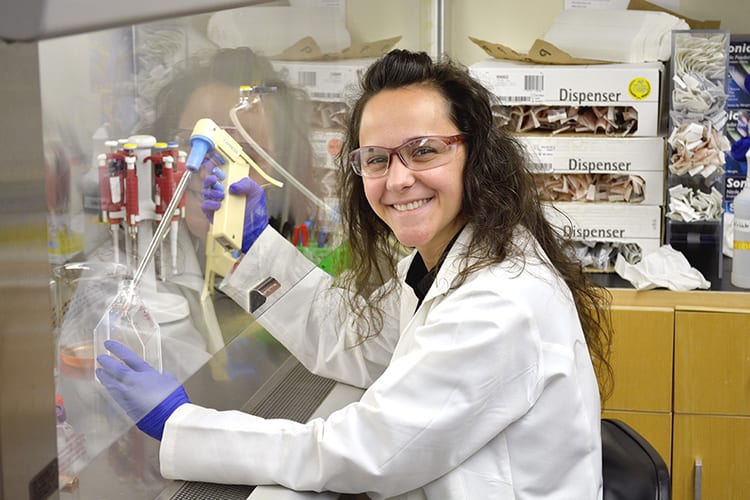
Tell me about your background.
I was born and raised in a small town in Northern Spain called Leon by the Cantabrian Mountains. I went to University of Leon for my Bachelor’s in Biology and Master’s in Animal Medicine and Surgery with a focus on Biomedical Engineering (BME). During my PhD, I received a fellowship to perform research at the University of Salamanca and Tissue Bank San Francisco Clinic Foundation in Spain with a focus on tissue engineering.
What led you to study at Washington University?
After finishing my PhD, I wanted to translate my previous expertise in tissue engineering into cancer models. I was offered a very exciting postdoctoral position by Kareem Azab, PhD, at Washington University. Washington University is one of the world’s leading research institutions. I was thrilled to join Washington University to increase training and expertise in cancer research with a focus in translational medicine and to further gain mentored training to successfully develop an academic research career.
What are your future career goals?
In June, I will start a leadership position as an independent investigator committed to translational cancer research at Sanford Research in South Dakota. My goal is to conduct cutting edge research in biomedical sciences to understand better the complexity of cancer and find models that allows us to recreate that complexity to further contribute to beat cancer.
How does it feel to be starting your own lab?
A lot of mixed feelings come to my mind. First, a dream come true, that’s the job I’ve always wanted — running my own lab! I can’t wait to hire the postdocs in my lab and start setting up experiments! Second, I will lie if I don’t say that I am nervous about this big step, but you know during these years I have learned that if you work hard enough (4 years PhD, 5 years as a Postdoc, 4 patent applications, 1 company, and 29 publications later…), you can get what you want!
Tell me about what you are currently working on.
Multiple myeloma (MM) is a hematological malignancy characterized by the proliferation of plasma cells in the bone marrow (BM), which remains incurable because most patients relapse or become refractory to the treatments. Classic tissue culture screenings to assess drug efficacy rely on cultures of MM cell lines neglecting the interaction of MM cells with the BM microenvironment, which was shown to play crucial roles in disease progression, metastasis, and drug resistance in MM. A unique 3D tissue-engineered bone marrow (3DTEBM) model was developed using myeloma patients’ bone marrow samples. This model allows to closely mimic the tumor “microenvironment” of an individual multiple myeloma (MM) patient by including the patient’s cells – cancerous and benign – whose interactions can help or inhibit the tumor cells’ growth. The 3DTEBM was able to successfully overcome several limitations of previous tissue culture screenings by recreating human MM cells interactions with their malignant microenvironment, simulating the complex 3D structural features of the disease, and taking into consideration the individual heterogeneity between MM patients. Moreover, the 3DTEBM was the first system to allow proliferation of primary MM cells “ex-vivo” for several weeks and induced drug resistance in these cells.
What has been the most challenging aspect of this specific area of study?
We are currently evaluating the ability of 3DTEBM to predict therapeutic efficacy of drugs for individual patients with myeloma retrospectively. If successful, this will lead to prospective studies for prediction of therapeutic efficacy in patients, where a spectrum of anti-cancer drugs will be screened and the 3DTEBM model will determine which drugs are most effective, to finally provide the results to clinicians and their patients.
What are your future plans for this subject/study?
We are working on further extending the same concept to other diseases, since the BM-microenvironment was shown to play a crucial role in other hematologic malignancies such as leukemia and lymphoma.
Was there something in particular that led you to this subject of research?
I developed patient-derived 3D cultures model made of patients’ plasma during my PhD with an emphasis on tissue engineering. The tumor microenvironment is highly complex and the introduction of exogenous materials affects significantly the cellular behavior. We thought that the used of these cultures models will allow for a better recreation of the tumor microenvironment to help us evaluate the role of the tumor microenvironment in tumor progression and drug resistance.
Any other comments?
I want to thank everyone in the Department of Radiation Oncology, especially my amazing mentor, Dr. Azab, and the great lab mates in the Azab Lab. I will miss very much all of you, but I am also very excited to start a new adventure as an independent investigator. Please do not hesitate, come and visit me in South Dakota 🙂
Pilar de la Puente is a member of the Azab Lab.